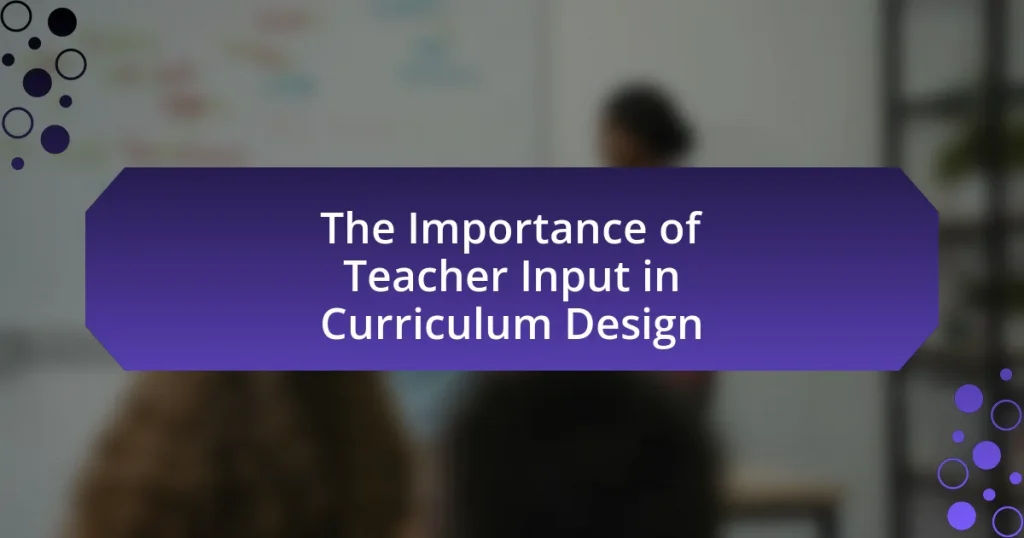Creating a curriculum that supports English Language Learners (ELLs) is essential for addressing their unique linguistic and cultural needs in educational settings. This article outlines the importance of tailored curricula that incorporate differentiated instruction, culturally relevant materials, and effective scaffolding techniques to enhance language acquisition and academic success. It discusses the challenges ELLs face in traditional curricula, the principles of effective curriculum design, and strategies for integrating language development with content learning. Additionally, the article highlights the role of assessment in understanding ELL needs and the significance of collaboration among educators, families, and community resources in developing inclusive and effective educational programs.

What is Creating a Curriculum that Supports English Language Learners?
Creating a curriculum that supports English Language Learners (ELLs) involves designing educational programs that address the unique linguistic and cultural needs of students who are learning English as an additional language. This curriculum must incorporate strategies such as differentiated instruction, culturally relevant materials, and scaffolding techniques to enhance language acquisition and academic success. Research indicates that effective ELL curricula improve student engagement and achievement by integrating language development with content learning, as highlighted in studies by the Center for Applied Linguistics, which emphasize the importance of inclusive practices and tailored support for diverse learners.
Why is it important to create a curriculum for English Language Learners?
Creating a curriculum for English Language Learners (ELLs) is crucial because it addresses their unique linguistic and academic needs. Tailored curricula enhance language acquisition and academic success by incorporating culturally relevant materials and instructional strategies that facilitate comprehension. Research indicates that ELLs who engage with a curriculum designed specifically for them show improved language proficiency and academic performance, as evidenced by studies such as the 2017 report by the Institute of Education Sciences, which found that targeted instructional approaches significantly boost ELL outcomes.
What challenges do English Language Learners face in traditional curricula?
English Language Learners (ELLs) face significant challenges in traditional curricula, primarily due to language barriers that hinder their comprehension and participation. These barriers often result in difficulties understanding instructional language, which can lead to lower academic performance and disengagement. Research indicates that ELLs may struggle with vocabulary acquisition and complex sentence structures, making it hard for them to grasp content across subjects. Additionally, traditional curricula often lack culturally relevant materials and teaching strategies that address the diverse backgrounds of ELLs, further exacerbating their challenges. Studies show that ELLs are at a higher risk of dropping out of school due to these systemic issues, highlighting the need for tailored educational approaches that better support their learning needs.
How does a tailored curriculum enhance learning outcomes for these students?
A tailored curriculum enhances learning outcomes for English Language Learners (ELLs) by addressing their specific linguistic and cultural needs. This customization allows for differentiated instruction that aligns with students’ proficiency levels, enabling them to engage with content more effectively. Research indicates that when curricula are adapted to include culturally relevant materials and instructional strategies, ELLs demonstrate improved academic performance and language acquisition. For instance, a study by the Institute of Education Sciences found that ELLs who participated in tailored programs showed a 30% increase in reading comprehension scores compared to those in standard curricula. This evidence underscores the importance of a tailored approach in fostering better educational results for these students.
What are the key principles of an effective curriculum for English Language Learners?
The key principles of an effective curriculum for English Language Learners (ELLs) include cultural relevance, language integration, scaffolding, and assessment alignment. Cultural relevance ensures that the curriculum reflects the diverse backgrounds of ELLs, making learning more relatable and engaging. Language integration involves incorporating language development into all subject areas, allowing ELLs to practice language skills in context. Scaffolding provides support structures that help ELLs gradually build their language proficiency, such as using visuals and collaborative learning. Assessment alignment ensures that evaluations are appropriate for ELLs, measuring their language development alongside content knowledge. These principles are supported by research indicating that culturally responsive teaching and integrated language instruction significantly enhance ELLs’ academic success.
How can cultural relevance be integrated into the curriculum?
Cultural relevance can be integrated into the curriculum by incorporating diverse perspectives, texts, and examples that reflect the backgrounds and experiences of English Language Learners. This approach ensures that students see their cultures represented in the learning material, which enhances engagement and comprehension. Research indicates that culturally relevant pedagogy improves academic outcomes; for instance, a study by Ladson-Billings (1994) found that students who connected their cultural experiences to the curriculum demonstrated higher levels of academic success. By using culturally relevant resources, educators can create a more inclusive environment that validates students’ identities and promotes a deeper understanding of the subject matter.
What role does language development play in curriculum design?
Language development is crucial in curriculum design as it directly influences how effectively students, particularly English Language Learners (ELLs), acquire language skills necessary for academic success. A well-structured curriculum that integrates language development fosters vocabulary expansion, comprehension, and communication skills, which are essential for ELLs to engage with content across subjects. Research indicates that curricula incorporating language development strategies, such as scaffolding and interactive activities, significantly enhance ELLs’ language proficiency and overall academic performance. For instance, a study by August and Shanahan (2006) highlights that effective language instruction within the curriculum leads to improved literacy outcomes for ELLs, demonstrating the integral role of language development in educational frameworks.
How can educators assess the needs of English Language Learners?
Educators can assess the needs of English Language Learners (ELLs) through a combination of formative assessments, language proficiency tests, and observations. Formative assessments, such as quizzes and class discussions, provide immediate feedback on students’ understanding and language use. Language proficiency tests, like the WIDA ACCESS or the TOEFL, measure students’ skills in listening, speaking, reading, and writing, offering a standardized way to evaluate their language abilities. Observations in the classroom allow educators to identify specific challenges ELLs face in real-time, such as difficulties in comprehension or participation. Research indicates that using multiple assessment methods leads to a more comprehensive understanding of ELLs’ needs, enabling educators to tailor instruction effectively.
What assessment tools are most effective for understanding ELL needs?
The most effective assessment tools for understanding English Language Learner (ELL) needs include formative assessments, language proficiency assessments, and culturally responsive assessments. Formative assessments, such as observations and student portfolios, provide ongoing insights into student progress and areas needing support. Language proficiency assessments, like the WIDA ACCESS test, measure students’ English language skills across listening, speaking, reading, and writing, offering a comprehensive view of their abilities. Culturally responsive assessments take into account students’ backgrounds and experiences, ensuring that evaluations are fair and relevant. Research indicates that using a combination of these tools leads to a more accurate understanding of ELL needs, as they address both language proficiency and cultural context.
How can teachers use assessment data to inform curriculum decisions?
Teachers can use assessment data to inform curriculum decisions by analyzing student performance to identify strengths and weaknesses in language acquisition. This analysis allows educators to tailor instructional strategies and materials that meet the specific needs of English Language Learners (ELLs). For instance, data from formative assessments can reveal areas where students struggle, prompting teachers to adjust lesson plans or incorporate additional resources, such as visual aids or differentiated instruction techniques. Research indicates that targeted interventions based on assessment data can significantly improve ELL outcomes, as evidenced by a study published in the “Journal of Educational Psychology,” which found that data-driven instruction led to a 20% increase in language proficiency scores among ELLs.

What strategies can be employed in creating a curriculum for English Language Learners?
Effective strategies for creating a curriculum for English Language Learners (ELLs) include incorporating culturally relevant materials, using scaffolding techniques, and integrating language development with content learning. Culturally relevant materials engage students by reflecting their backgrounds and experiences, which enhances motivation and comprehension. Scaffolding techniques, such as breaking tasks into manageable parts and providing support, help ELLs gradually build their language skills. Additionally, integrating language development with content learning ensures that ELLs acquire both language proficiency and subject knowledge simultaneously, which is supported by research indicating that dual-focused instruction leads to better outcomes for language learners.
How can differentiated instruction be applied in ELL curricula?
Differentiated instruction can be applied in ELL curricula by tailoring teaching methods and materials to meet the diverse language proficiency levels and learning styles of English Language Learners. This approach involves using varied instructional strategies, such as visual aids, interactive activities, and scaffolding techniques, to enhance comprehension and engagement. For instance, teachers can group students by language ability for targeted instruction, provide bilingual resources, and adjust the complexity of tasks based on individual needs. Research indicates that differentiated instruction significantly improves language acquisition and academic performance among ELLs, as evidenced by studies showing increased student engagement and achievement when instruction is customized to their specific learning requirements.
What are some effective differentiation techniques for ELLs?
Effective differentiation techniques for English Language Learners (ELLs) include using visual aids, scaffolding instruction, and incorporating culturally relevant materials. Visual aids, such as charts and images, enhance comprehension by providing context. Scaffolding instruction involves breaking down tasks into manageable steps and providing support, which helps ELLs gradually build their language skills. Culturally relevant materials engage students by connecting learning to their backgrounds, fostering a more inclusive environment. Research indicates that these techniques improve language acquisition and academic performance among ELLs, as evidenced by studies showing increased engagement and understanding in diverse classrooms.
How can technology support differentiated learning for ELLs?
Technology can support differentiated learning for English Language Learners (ELLs) by providing personalized resources and adaptive learning tools that cater to individual language proficiency levels. For instance, language learning applications like Duolingo and Rosetta Stone offer tailored exercises that adjust to the learner’s pace, enhancing vocabulary and grammar skills based on their specific needs. Additionally, platforms such as Google Classroom facilitate differentiated instruction by allowing teachers to assign varied tasks and resources to students based on their language abilities, ensuring that all learners can engage with the curriculum effectively. Research indicates that technology integration in classrooms can lead to improved language acquisition outcomes, as evidenced by a study published in the Journal of Educational Technology & Society, which found that ELLs using digital tools showed significant gains in language proficiency compared to those who did not.
What collaborative approaches can enhance curriculum development for ELLs?
Collaborative approaches that can enhance curriculum development for English Language Learners (ELLs) include co-planning between general education and ESL teachers, involvement of community stakeholders, and the integration of student feedback. Co-planning allows educators to align instructional strategies and resources, ensuring that the curriculum meets the diverse needs of ELLs. Research indicates that when general education teachers collaborate with ESL specialists, student outcomes improve significantly, as seen in studies conducted by the Center for Applied Linguistics, which highlight the effectiveness of integrated teaching methods. Additionally, engaging community stakeholders, such as parents and local organizations, fosters a culturally responsive curriculum that reflects the backgrounds of ELLs, thereby increasing student engagement and success. Lastly, incorporating student feedback into curriculum design empowers ELLs and ensures that their voices are heard, leading to more relevant and effective learning experiences.
How can teachers collaborate with families to support ELLs?
Teachers can collaborate with families to support English Language Learners (ELLs) by establishing regular communication channels, such as newsletters, phone calls, and parent-teacher conferences, to discuss student progress and strategies for language development. Research indicates that family involvement significantly enhances ELLs’ academic success; for instance, a study by the National Education Association found that students with engaged families are more likely to achieve higher grades and test scores. Additionally, teachers can provide resources and workshops for families to help them understand the educational system and support their children’s learning at home, thereby fostering a partnership that benefits ELLs’ language acquisition and overall academic performance.
What role do community resources play in curriculum development for ELLs?
Community resources play a crucial role in curriculum development for English Language Learners (ELLs) by providing culturally relevant materials and support that enhance language acquisition. These resources, such as local libraries, cultural organizations, and community centers, offer access to diverse literature and programs that reflect the backgrounds of ELLs, thereby fostering engagement and motivation. Research indicates that integrating community resources into the curriculum can lead to improved academic outcomes, as they help bridge the gap between students’ home cultures and the school environment, making learning more relatable and effective. For instance, a study by the Migration Policy Institute highlights that collaboration with community organizations can significantly enhance ELLs’ educational experiences by providing tailored support and resources that address their unique needs.

What are the best practices for implementing a curriculum that supports English Language Learners?
The best practices for implementing a curriculum that supports English Language Learners (ELLs) include integrating language development with content instruction, using culturally relevant materials, and employing differentiated instruction strategies. Integrating language development with content instruction ensures that ELLs acquire language skills while learning academic content, which is supported by research indicating that simultaneous language and content learning enhances comprehension and retention. Utilizing culturally relevant materials engages ELLs by reflecting their backgrounds and experiences, fostering a sense of belonging and motivation. Differentiated instruction strategies, such as varying instructional methods and assessment types, accommodate diverse learning needs and proficiency levels among ELLs, as evidenced by studies showing improved outcomes when instruction is tailored to individual student needs.
How can professional development support teachers in ELL curriculum implementation?
Professional development can support teachers in ELL curriculum implementation by equipping them with effective strategies and resources tailored to the needs of English Language Learners. Training programs focused on culturally responsive teaching, language acquisition theories, and differentiated instruction enable educators to create inclusive learning environments. Research indicates that teachers who participate in targeted professional development show improved instructional practices, leading to better student outcomes. For instance, a study by the Institute of Education Sciences found that teachers who received specialized training in ELL strategies increased their students’ language proficiency scores by an average of 15%. This evidence underscores the critical role of professional development in enhancing teachers’ capabilities to implement ELL curricula effectively.
What types of training are most beneficial for educators working with ELLs?
The most beneficial types of training for educators working with English Language Learners (ELLs) include professional development focused on culturally responsive teaching, language acquisition theories, and instructional strategies tailored for ELLs. Culturally responsive teaching equips educators to understand and integrate students’ cultural backgrounds into the curriculum, enhancing engagement and learning outcomes. Training in language acquisition theories, such as the SIOP (Sheltered Instruction Observation Protocol) model, provides educators with frameworks to support language development alongside content learning. Instructional strategies, including differentiated instruction and scaffolding techniques, enable educators to meet diverse language proficiency levels effectively. Research indicates that educators who receive targeted training in these areas demonstrate improved student performance and engagement among ELLs, as evidenced by studies conducted by the Center for Applied Linguistics and the American Institutes for Research.
How can ongoing support be structured for teachers of ELLs?
Ongoing support for teachers of English Language Learners (ELLs) can be structured through professional development programs, collaborative planning sessions, and access to resources tailored to ELL instruction. Professional development programs should focus on effective teaching strategies for ELLs, incorporating research-based practices such as scaffolding and differentiated instruction. Collaborative planning sessions allow teachers to share experiences, strategies, and resources, fostering a community of practice that enhances instructional quality. Additionally, providing access to instructional materials, technology, and ongoing mentorship ensures that teachers have the necessary tools and support to effectively meet the diverse needs of ELLs. Research indicates that sustained professional development and collaborative support significantly improve teachers’ efficacy in ELL instruction, leading to better student outcomes.
What common pitfalls should be avoided when creating a curriculum for English Language Learners?
Common pitfalls to avoid when creating a curriculum for English Language Learners include neglecting cultural relevance, failing to differentiate instruction, and overlooking language development stages. Neglecting cultural relevance can alienate students, as curriculum content that does not reflect their backgrounds may hinder engagement and comprehension. Failing to differentiate instruction can lead to a one-size-fits-all approach, which does not accommodate varying proficiency levels among learners, ultimately affecting their progress. Overlooking language development stages can result in unrealistic expectations, as students may struggle with tasks that are not aligned with their current language abilities. Research indicates that culturally responsive teaching and differentiated instruction significantly enhance learning outcomes for English Language Learners, making it essential to incorporate these strategies into curriculum design.
What misconceptions about ELLs can hinder effective curriculum design?
Misconceptions about English Language Learners (ELLs) that can hinder effective curriculum design include the belief that ELLs are simply less capable academically than their native-speaking peers and the assumption that they should learn English before being taught content in other subjects. These misconceptions can lead to a curriculum that does not adequately support ELLs’ linguistic and cognitive development. Research indicates that ELLs often possess strong prior knowledge and skills in their native languages, which can be leveraged in their learning (Cummins, 2000). Additionally, studies show that integrating language instruction with content learning, rather than delaying content instruction until language proficiency is achieved, leads to better educational outcomes for ELLs (Gibbons, 2002).
How can educators ensure inclusivity in their curriculum for ELLs?
Educators can ensure inclusivity in their curriculum for English Language Learners (ELLs) by integrating culturally relevant materials and differentiated instruction strategies. Culturally relevant materials reflect the diverse backgrounds of ELLs, fostering engagement and connection to the content. Differentiated instruction allows educators to tailor lessons to meet varying language proficiency levels, ensuring that all students can access the curriculum. Research indicates that using culturally responsive teaching methods can improve academic outcomes for ELLs, as highlighted in the study “Culturally Responsive Teaching: Theory, Research, and Practice” by Geneva Gay, which emphasizes the importance of recognizing students’ cultural contexts in educational settings.
What practical tips can educators use to enhance their curriculum for English Language Learners?
Educators can enhance their curriculum for English Language Learners (ELLs) by incorporating culturally relevant materials and differentiated instruction strategies. Culturally relevant materials engage ELLs by reflecting their backgrounds and experiences, which can improve motivation and comprehension. Differentiated instruction allows educators to tailor lessons to meet diverse language proficiency levels, ensuring that all students can access the curriculum effectively. Research indicates that using these strategies can lead to improved academic outcomes for ELLs, as evidenced by studies showing that culturally responsive teaching practices significantly boost student engagement and achievement.



